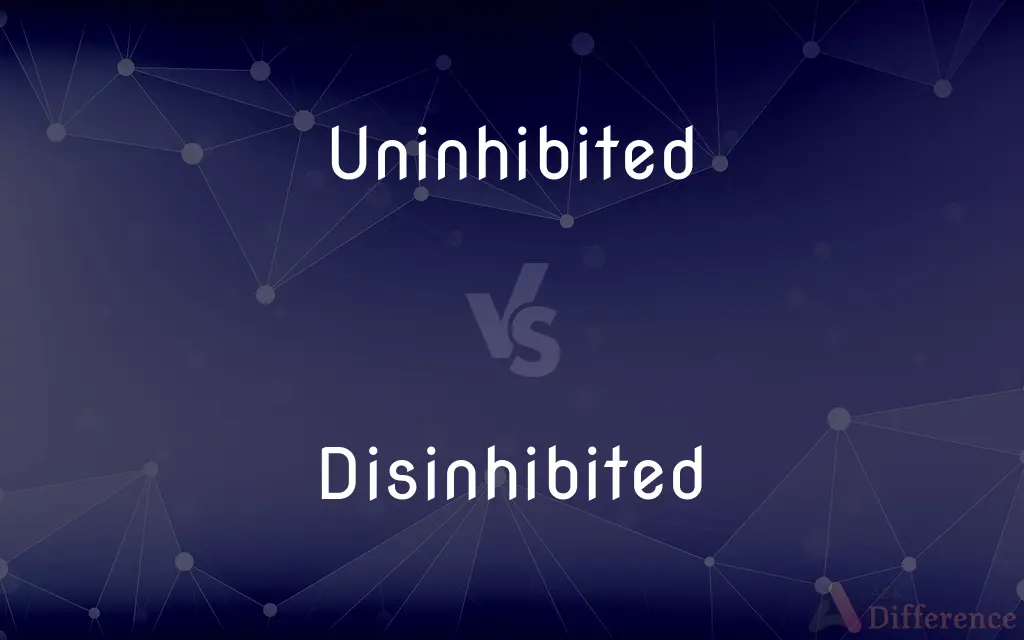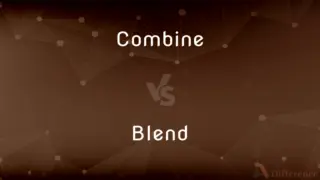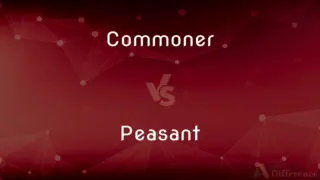Uninhibited vs. Disinhibited — What's the Difference?
Edited by Tayyaba Rehman — By Urooj Arif — Updated on March 27, 2024
Uninhibited describes a natural lack of restraint, while disinhibited refers to a reduction or loss of restraint due to external factors.

Difference Between Uninhibited and Disinhibited
Table of Contents
ADVERTISEMENT
Key Differences
Uninhibited behavior is characterized by a natural freedom and spontaneity, showing a person's innate tendency to act without feeling self-conscious or restrained. On the other hand, disinhibited behavior often results from an alteration in brain function or the influence of substances, leading to a noticeable decrease in social inhibitions that were previously present.
While an uninhibited person might naturally engage in open and expressive communication, seeing it as part of their personality, a disinhibited individual may display sudden changes in behavior, such as inappropriate comments or actions, that deviate from their usual conduct. This contrast highlights the innate versus acquired aspects of social and emotional expression.
In terms of development, uninhibited behavior can be seen as a trait that individuals exhibit consistently across different situations, often from an early age. Disinhibited behavior, however, can emerge at any stage of life, often as a response to specific circumstances, including traumatic experiences, neurological disorders, or the effects of drugs or alcohol.
Uninhibited individuals often thrive in creative and expressive fields, where their natural lack of restraint is seen as an asset, allowing for innovation and originality. Conversely, disinhibited behavior might cause social and professional difficulties, as the behaviors can be unpredictable and contextually inappropriate, leading to misunderstandings or conflicts.
The distinction between being uninhibited and disinhibited also lies in the perception and reaction of others. Uninhibited behavior is generally consistent and may be perceived as a charming or integral part of one's personality, whereas disinhibited behavior can be alarming or concerning to observers, signaling a possible underlying issue that requires attention.
ADVERTISEMENT
Comparison Chart
Definition
Exhibiting a natural lack of restraint, often seen as part of one’s personality.
A reduction or loss of restraint due to external factors, such as brain function changes or substance influence.
Origin
Innate personality trait.
Acquired condition or response to external influences.
Behavioral Consistency
Consistently evident across various contexts.
Can emerge suddenly or in specific situations.
Perception by Others
Often viewed positively, as part of one's charm.
May be seen as concerning or indicative of an underlying issue.
Typical Contexts
Creative expressions, social interactions.
Often linked to trauma, neurological changes, or substance use.
Compare with Definitions
Uninhibited
Comfortable in one’s own skin.
He's uninhibited on stage, captivating the audience.
Disinhibited
Exhibiting impulsive actions.
She acted disinhibited, interrupting the meeting unexpectedly.
Uninhibited
Naturally expressive and free.
Her uninhibited laughter fills the room.
Disinhibited
Lacking usual social restraints.
His comments became disinhibited after a few drinks.
Uninhibited
Showing no reservation in emotions.
He showed an uninhibited display of joy.
Disinhibited
Showing inappropriate behavior.
His disinhibited behavior at work raised concerns.
Uninhibited
Open and candid in communication.
Her uninhibited remarks were refreshing.
Disinhibited
Result of neurological issues.
Disinhibited actions can be a sign of brain injury.
Uninhibited
Lively and spontaneous.
The party was full of uninhibited dancing.
Disinhibited
Induced by substances.
Alcohol can lead to disinhibited speech and actions.
Uninhibited
Free from inhibition; unrestrained or unselfconscious
Uninhibited laughter.
Disinhibited
To free (a person) from inhibitions.
Uninhibited
Not inhibited; having no inhibitions.
Disinhibited
To terminate or reverse the inhibition of (a neuron, for example).
Uninhibited
Not inhibited or restrained;
Uninhibited exuberance
Disinhibited
Simple past tense and past participle of disinhibit
Common Curiosities
What does uninhibited mean?
Uninhibited describes someone who naturally behaves freely and expressively, without self-consciousness.
How can you tell if behavior is uninhibited or disinhibited?
Context and consistency are key; uninhibited behavior is a trait, while disinhibited behavior often indicates an external influence or change.
Can cultural differences affect perceptions of uninhibited or disinhibited behavior?
Absolutely, cultural norms greatly influence what is considered appropriate or excessive in terms of expressiveness.
What does disinhibited mean?
Disinhibited refers to a loss or reduction of social inhibitions, often due to external factors like substances or brain function changes.
How does society typically view uninhibited individuals?
Views can vary widely, from admiration for their authenticity to concerns over lack of restraint, depending on the context.
Can someone be both uninhibited and disinhibited?
While they stem from different origins, certain contexts might blur the lines, with substances amplifying a naturally uninhibited personality.
Is being uninhibited always positive?
It can be seen as positive in contexts where spontaneity and openness are valued, though it may not always be appropriate in all settings.
What causes someone to be uninhibited?
It's often an innate personality trait, where individuals naturally feel less constrained by societal norms.
Are disinhibited behaviors treatable?
Yes, if resulting from conditions or substance use, appropriate treatment and interventions can help manage disinhibited behaviors.
What are common causes of disinhibition?
Causes include brain injuries, dementia, the influence of drugs or alcohol, and certain psychological conditions.
How can someone manage disinhibited behavior?
Management strategies include therapy, medication for underlying conditions, and developing coping mechanisms for impulse control.
Does the environment influence whether behavior is seen as uninhibited or disinhibited?
Yes, the social and cultural context can greatly affect how such behaviors are perceived and judged.
Is disinhibition a symptom of specific medical conditions?
Yes, conditions like Alzheimer's disease, traumatic brain injury, and certain frontal lobe disorders can feature disinhibition.
Can disinhibition affect professional relationships?
Yes, disinhibited behavior can lead to misunderstandings, conflicts, or breaches of professional etiquette.
What role does upbringing play in uninhibited behavior?
Upbringing can influence how comfortable individuals feel expressing themselves, though innate personality factors also play a significant role.
Share Your Discovery

Previous Comparison
Combine vs. Blend
Next Comparison
Commoner vs. PeasantAuthor Spotlight
Written by
Urooj ArifUrooj is a skilled content writer at Ask Difference, known for her exceptional ability to simplify complex topics into engaging and informative content. With a passion for research and a flair for clear, concise writing, she consistently delivers articles that resonate with our diverse audience.
Edited by
Tayyaba RehmanTayyaba Rehman is a distinguished writer, currently serving as a primary contributor to askdifference.com. As a researcher in semantics and etymology, Tayyaba's passion for the complexity of languages and their distinctions has found a perfect home on the platform. Tayyaba delves into the intricacies of language, distinguishing between commonly confused words and phrases, thereby providing clarity for readers worldwide.













































